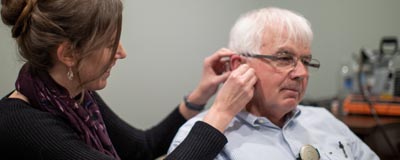What is hearing aid feedback and why does it happen?
Feedback is caused when sound from a speaker enters a microphone and is reamplified over and over, getting louder each time until it pushes the system to capacity. In an auditorium it is the loud squeal we hear from time to time when the microphone set too high or is placed in front of the speaker. In hearing aids, feedback results in a whistling sound. In custom hearing aids which are fit completely in the ear, the microphone is located on the outer surface and the speakers are located in the canal of the hearing aid. Behind-the-Ear hearing aids place their microphones directly behind the ear and the speaker feeds into a tube which loops down into the ear mold inserted in the ear canal. In either system, if enough sound leaks out of the ear and reaches the microphone, there is a chance of feedback to occur. The likely hood of feedback increases with the severity of the hearing gloss, and is more prevalent in fully in the ear models than in Behind-the-Ear versions for the same volume output. This is due to the fact that the Behind-the-Ear hearing aid has a larger separation between the microphones and where the sound leaves the ear mold, minimizing the likelihood that sound will reach the microphone again.
There have been huge technological improvements in minimizing hearing aid feedback over the past 5 years. When fitting a new hearing aid, feedback is now one of the first issues addressed by audiologists and hearing instrument practitioners. Professionals use a “feedback calibration test” designed by the hearing aid manufacturer to properly program the hearing aids to recognize when feedback may occur and to create settings to reduce the likelihood of its presence under normal circumstances. This allows properly fitted new hearing aids to work to maximum potential without the nuisance of feedback.
However, as time passes, there can be several reasons why feedback may occur. These can include, but are not limited to: a build up of ear wax in the canal, the hearing aid or mold becoming loose in the ear canal, a tear, cut or damage to the sound tube, or damage to the electronics. If feedback should develop, please schedule an appointment to come in so that our hearing professionals can assess what the cause is and help you remedy it.





